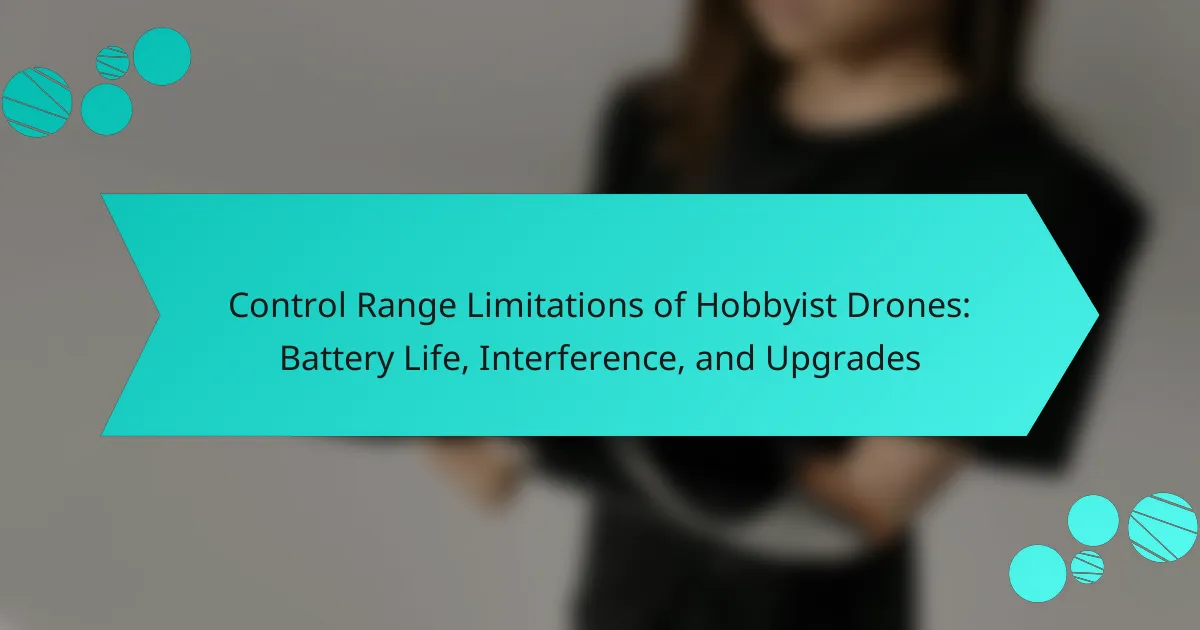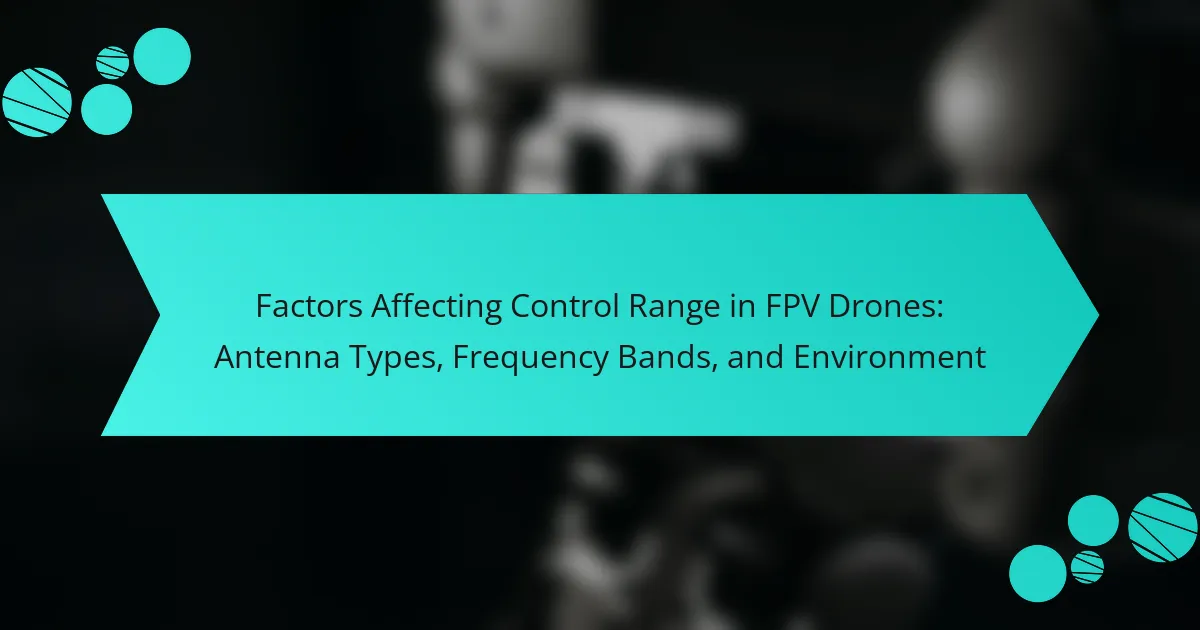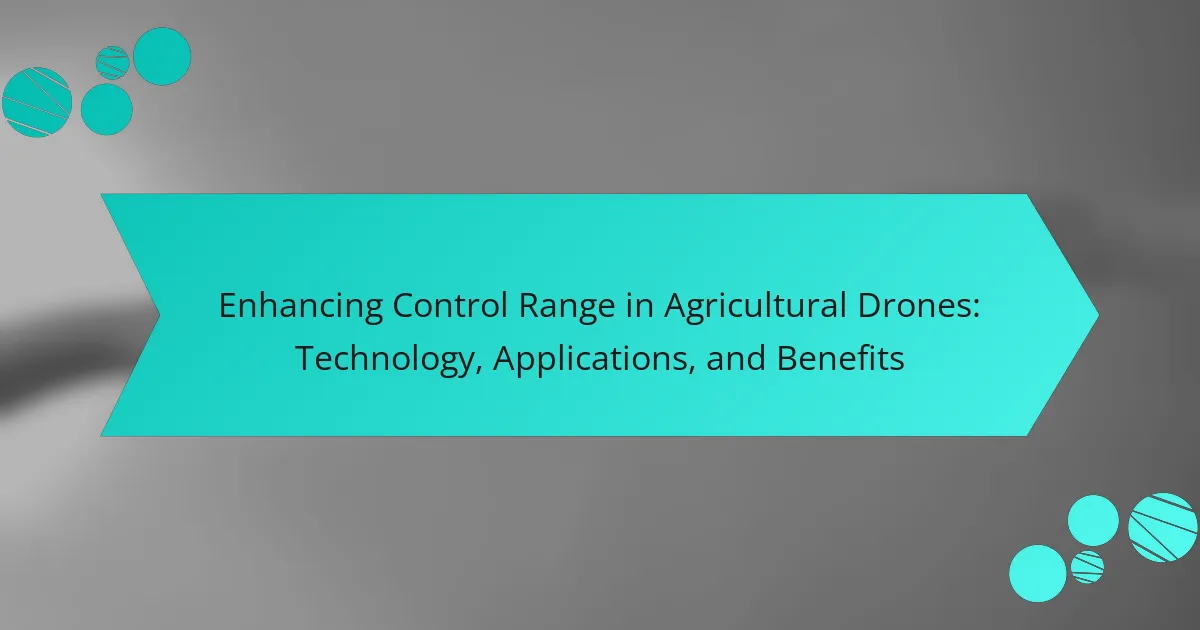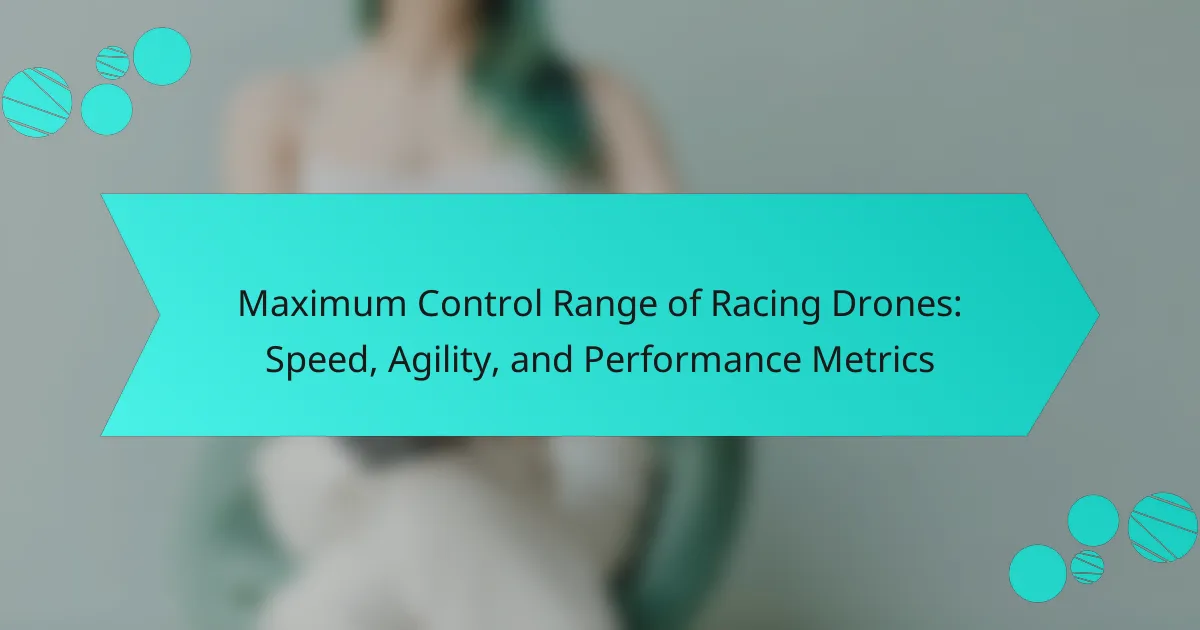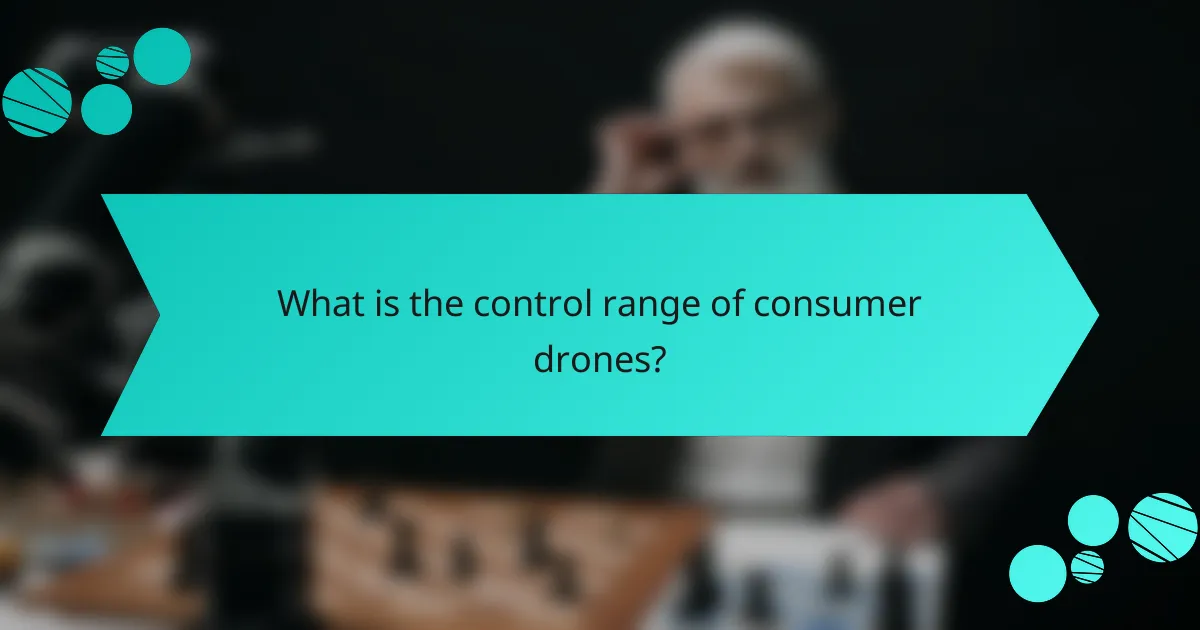
What is the control range of consumer drones?
The control range of consumer drones typically varies between 1 to 7 kilometers. Most entry-level models have a range of about 1 kilometer. Mid-range consumer drones can reach up to 3 kilometers. High-end models often exceed 7 kilometers under optimal conditions. Factors influencing this range include signal quality, environmental conditions, and interference. For instance, urban areas with many obstacles can reduce the effective range. In contrast, open areas can maximize the control distance. These specifications are often detailed in the product manuals provided by manufacturers.
How is the control range defined and measured?
The control range of consumer drones is defined as the maximum distance over which the drone can be effectively controlled by the operator. This range is measured using the strength of the radio signal between the drone and the remote controller. Factors such as frequency, transmission power, and environmental conditions influence this measurement. Typically, manufacturers specify control ranges in meters or kilometers in the drone’s technical specifications. For example, many consumer drones have a control range of up to 4 kilometers under optimal conditions. Testing often involves flying the drone in an open area while monitoring signal strength. When the signal weakens, the control range is determined by the last point of stable communication.
What are the standard units of measurement for control range?
The standard units of measurement for control range are meters and kilometers. These units quantify the distance a drone can be effectively controlled from its operator. The control range is critical for ensuring safe operation and optimal performance. In consumer drones, control ranges typically vary from a few hundred meters to several kilometers. For instance, many popular consumer drones boast a control range of 1 to 5 kilometers. This measurement is essential for users to understand how far they can operate their drones without losing signal.
How does control range vary among different drone models?
Control range varies significantly among different drone models. High-end drones often have a control range exceeding 7 kilometers. Mid-range models typically offer a control range of 2 to 5 kilometers. Budget drones usually have a control range of around 1 kilometer or less. Factors influencing control range include transmission technology and antenna design. For example, drones using 2.4 GHz frequency can achieve longer ranges compared to those using 5.8 GHz. Additionally, environmental conditions such as obstacles and interference can affect the effective control range. Manufacturers often specify control range in product specifications, providing users with essential information for selection.
What factors influence the control range of consumer drones?
The control range of consumer drones is influenced by several factors. These include transmission power, frequency bands, and environmental conditions. Higher transmission power typically extends the control range. Drones operating on 2.4 GHz frequency often have a longer range than those on 5.8 GHz. Obstacles such as buildings and trees can obstruct signals, reducing range. Additionally, interference from other electronic devices impacts signal quality. Battery life also plays a role; a fully charged battery can maintain signal strength longer. Finally, the drone’s design and antenna quality significantly affect its control range.
How does the frequency of the control signal affect range?
The frequency of the control signal directly influences the range of consumer drones. Higher frequency signals typically allow for greater bandwidth, which can enhance data transmission rates. However, they also have shorter wavelengths, leading to increased sensitivity to obstacles and environmental interference. In contrast, lower frequency signals tend to penetrate obstacles better, resulting in a more reliable range in complex environments. Empirical studies show that drones operating on 2.4 GHz frequencies often achieve longer ranges compared to those at 5.8 GHz due to reduced signal attenuation. This relationship between frequency and range is critical for optimizing drone performance in various applications.
What role does the environment play in determining control range?
The environment significantly affects the control range of consumer drones. Factors such as terrain, obstacles, and weather conditions directly influence signal transmission. For instance, urban areas with tall buildings can obstruct signals, reducing range. In contrast, open fields allow for greater control distances. Weather conditions like rain or fog can also attenuate signals, further limiting range. Studies show that wireless signals can degrade by up to 20% in adverse weather. Additionally, electromagnetic interference from nearby devices can disrupt communication between the drone and controller. Therefore, understanding the environmental context is crucial for optimizing drone performance.
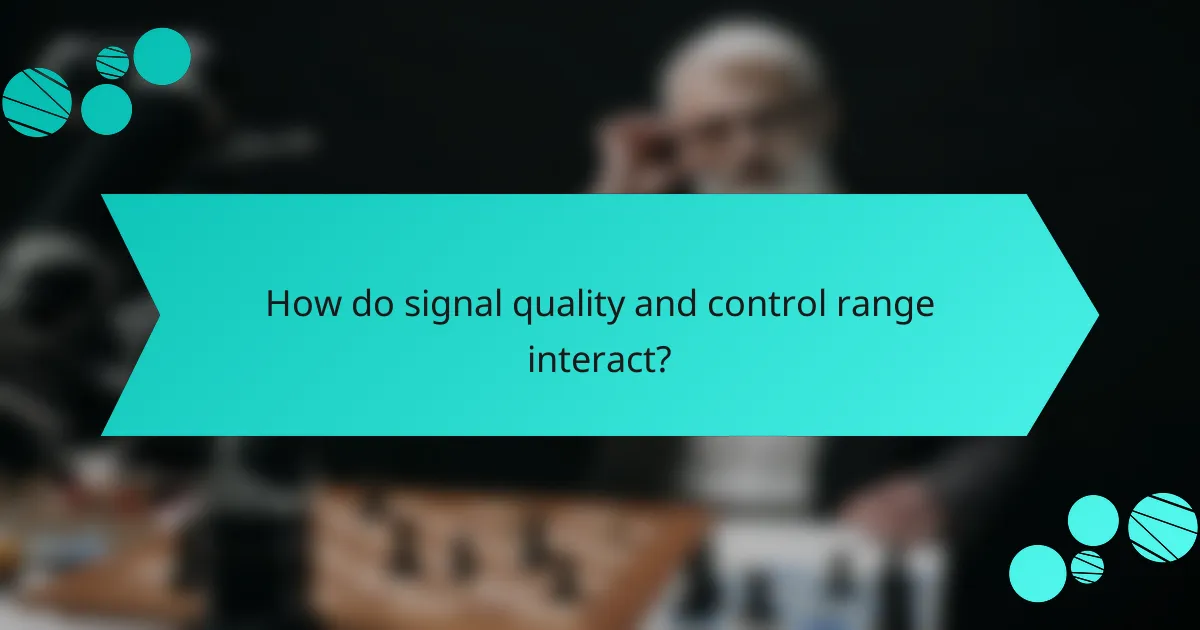
How do signal quality and control range interact?
Signal quality and control range are directly interconnected. Higher signal quality typically extends control range. When signal quality is strong, communication between the drone and controller remains stable over longer distances. Conversely, poor signal quality can lead to reduced control range. In scenarios with weak signals, the drone may lose connection or experience latency. This relationship is evident in consumer drones, where manufacturers specify maximum ranges based on optimal signal conditions. For example, a drone rated for a 4 km range may only achieve that distance under ideal signal quality. Thus, maintaining signal integrity is crucial for maximizing control range.
What is signal quality and why is it important?
Signal quality refers to the clarity and strength of a communication signal. It is crucial for effective data transmission between devices. High signal quality ensures reliable control and communication with consumer drones. Poor signal quality can lead to interruptions, loss of control, or degraded video feed. Research indicates that signal quality directly impacts the operational range of drones. For instance, a study by the Journal of Unmanned Vehicle Systems highlights that signal degradation can reduce flight distance significantly. Thus, maintaining high signal quality is essential for safe and efficient drone operation.
How is signal quality assessed in consumer drones?
Signal quality in consumer drones is assessed through various metrics. These metrics include signal strength, signal-to-noise ratio, and latency. Signal strength indicates how well the drone receives and transmits data. A higher signal strength correlates with better operational performance. Signal-to-noise ratio measures the clarity of the signal against background noise. A higher ratio signifies a clearer communication channel. Latency refers to the delay in signal transmission. Lower latency ensures more responsive control and real-time data feedback. These assessments are crucial for ensuring safe and effective drone operation.
What impact does poor signal quality have on drone performance?
Poor signal quality negatively impacts drone performance by causing loss of control and reduced operational range. Drones rely on stable communication links for navigation and control. When signal quality deteriorates, the drone may experience delayed responses to commands. This can lead to erratic flight paths or unintentional crashes. Additionally, poor signal can result in lower video transmission quality, affecting real-time monitoring. A study by the Federal Aviation Administration indicates that signal interference is a leading cause of drone accidents. Overall, maintaining strong signal quality is crucial for safe and effective drone operation.
How can users optimize signal quality to enhance control range?
Users can optimize signal quality to enhance control range by minimizing interference and maximizing line-of-sight. Keeping the drone in an open area reduces obstructions. Avoiding physical barriers like buildings and trees improves signal clarity. Users should also ensure the transmitter antennas are properly oriented. Regularly updating firmware can enhance communication protocols. Using high-gain antennas can strengthen the signal. Additionally, operating the drone at higher altitudes can reduce interference from ground obstacles. These methods collectively improve signal strength and control range, as evidenced by studies showing that line-of-sight increases effective communication distance.
What techniques can be employed to reduce interference?
Employing techniques such as frequency hopping, using directional antennas, and increasing transmission power can effectively reduce interference. Frequency hopping spreads the signal across various frequencies, minimizing the impact of interference on any single channel. Directional antennas focus the signal in a specific direction, enhancing signal strength and reducing interference from unwanted sources. Increasing transmission power strengthens the signal, allowing it to overcome interference more effectively. These methods are supported by research indicating that optimized signal transmission methods can significantly improve communication reliability in consumer drones.
How do antenna types influence signal quality and control range?
Antenna types significantly influence signal quality and control range in consumer drones. Different antenna designs, such as omnidirectional and directional antennas, affect how signals are transmitted and received. Omnidirectional antennas provide 360-degree coverage but may have lower signal quality over long distances. Directional antennas focus signals in a specific direction, enhancing range and quality but limiting coverage. The gain of an antenna, measured in dBi, determines its effectiveness; higher gain antennas can transmit signals over greater distances. For instance, a 9 dBi antenna can provide better performance than a 2 dBi antenna. Additionally, materials and construction of antennas can impact signal attenuation and interference. Therefore, selecting the appropriate antenna type is crucial for optimizing drone control range and signal quality.
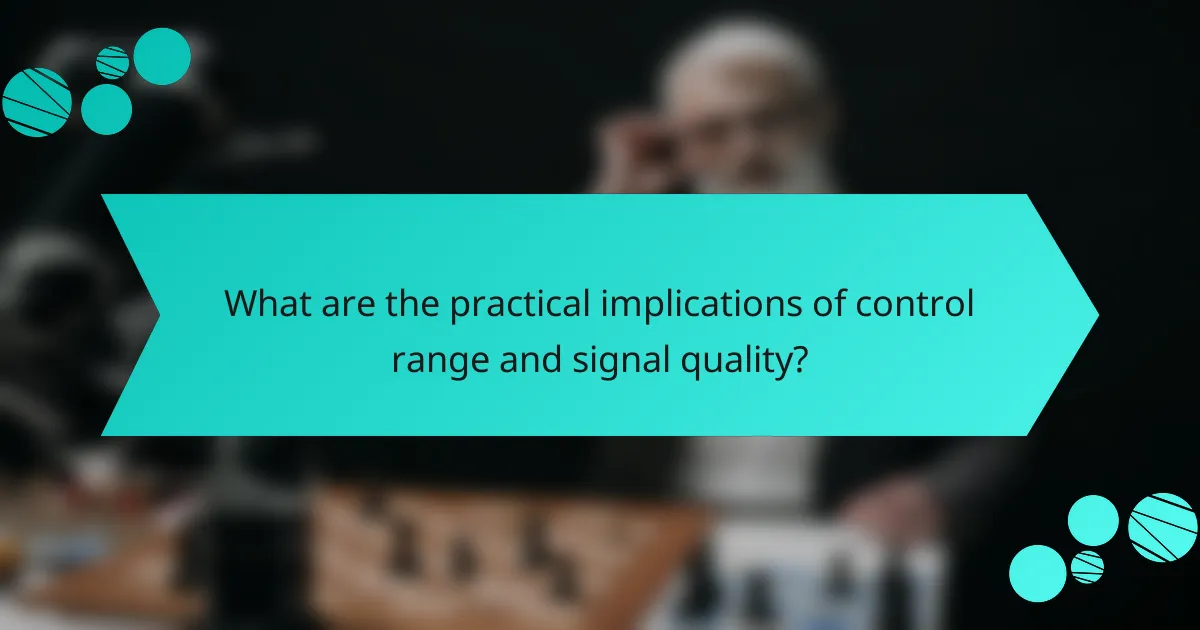
What are the practical implications of control range and signal quality?
Control range and signal quality are crucial for consumer drone operation. A limited control range can restrict the drone’s flight distance. This can lead to loss of signal and control, resulting in potential crashes. High signal quality ensures stable communication between the drone and the controller. Poor signal quality can cause delays or interruptions in command execution. These issues can affect safety and usability. For instance, a study by the Federal Aviation Administration (FAA) highlights that drones with better signal quality have lower accident rates. Thus, understanding these factors is vital for safe drone operation.
How can understanding control range improve drone operation?
Understanding control range enhances drone operation by optimizing flight performance and safety. A clear grasp of control range allows operators to maintain communication with the drone. This communication is crucial for real-time adjustments during flight. Knowing the limits helps prevent loss of control and potential crashes. For instance, consumer drones typically have a control range of 1 to 7 kilometers. Exceeding this range can lead to signal loss, causing the drone to become unresponsive. By adhering to the control range, operators can ensure consistent video feed and telemetry data. This improves overall mission success and reduces operational risks.
What are the best practices for maintaining optimal control range?
To maintain optimal control range for consumer drones, ensure a clear line of sight between the drone and the controller. This minimizes interference and maximizes signal strength. Avoid flying in areas with high electromagnetic interference, such as near power lines or radio towers. Regularly check and update the drone’s firmware to enhance performance and reliability. Use high-quality antennas to boost signal transmission and reception. Monitor battery levels closely, as low power can reduce control range. Lastly, adhere to local regulations regarding maximum flight distances to ensure compliance and safety. These practices collectively help in maintaining the drone’s control range effectively.
How can users troubleshoot common issues related to control range?
Users can troubleshoot common issues related to control range by following several steps. First, check the battery levels of both the drone and the remote controller. Low battery can significantly reduce the control range. Next, inspect the surrounding environment for potential interference. Obstacles such as buildings, trees, or other electronic devices can disrupt the signal.
Additionally, ensure that the firmware of the drone and the remote controller is up to date. Manufacturers often release updates to improve performance and signal quality. Users should also test the control range in open areas, away from potential obstructions.
Finally, if issues persist, consider resetting the drone’s settings to factory defaults. This can resolve any configuration problems affecting the control range. Following these steps can help users effectively troubleshoot control range issues.
What future developments could impact control range and signal quality?
Future developments in technology could significantly impact control range and signal quality for consumer drones. Advancements in antenna design may enhance signal transmission and reception. For instance, phased array antennas can provide better directionality and reduced interference. The implementation of 5G technology is expected to improve data transfer rates and reduce latency. Enhanced battery technology could extend operational range by providing longer flight times. Additionally, the development of AI algorithms for real-time signal optimization may improve connectivity in challenging environments. Research indicates that these advancements could lead to more reliable drone operations in urban and rural settings.
How might advancements in technology enhance control range?
Advancements in technology can enhance control range by improving transmission protocols and increasing signal strength. Enhanced signal strength allows for longer distances between the controller and the drone. Advanced transmission protocols, such as frequency hopping and spread spectrum, reduce interference. These technologies enable more stable connections over greater distances. Additionally, innovations in antenna design can boost the effective range of signals. For example, directional antennas can focus signals towards the drone, enhancing communication quality. Furthermore, developments in battery technology can extend operational time, allowing drones to maintain control over longer distances. Overall, these technological improvements directly contribute to increased control range in consumer drones.
What trends are emerging in consumer drone signal technology?
Emerging trends in consumer drone signal technology include the adoption of advanced communication protocols. These protocols enhance the reliability and range of drone operations. Additionally, many manufacturers are integrating 5G technology into drones. This integration allows for faster data transmission and improved control. Another trend is the use of frequency hopping spread spectrum (FHSS) technology. FHSS minimizes interference and enhances signal stability. Furthermore, the development of mesh networking capabilities is on the rise. This allows multiple drones to communicate with each other, extending the operational range. Enhanced GPS and GNSS technologies are also being implemented. These technologies improve positioning accuracy and overall flight performance.
What tips can help consumers choose the right drone based on control range?
Consumers should consider several factors when choosing a drone based on control range. First, evaluate the drone’s maximum control range specified by the manufacturer. This range can vary significantly between models, often from 300 meters to several kilometers. Next, consider the type of technology used for control, such as Wi-Fi or radio frequency. Radio frequency typically offers greater distances and reliability.
Additionally, check for the presence of features like GPS and Return-to-Home functions. These features enhance safety and usability, especially at longer ranges. Environmental factors also play a role; obstacles like buildings and trees can reduce effective range. Weather conditions, such as wind and rain, can impact signal strength and control distance.
Lastly, read user reviews and expert opinions on specific drone models. They often provide insights into real-world performance regarding control range.
The main entity of this article is the control range of consumer drones, which refers to the maximum distance over which a drone can be effectively controlled by its operator. The article provides a comprehensive overview of the factors influencing control range, including transmission power, frequency bands, environmental conditions, and signal quality. It discusses how different drone models exhibit varying control ranges, typically ranging from 1 to over 7 kilometers, and highlights the importance of understanding these parameters for safe and effective drone operation. Additionally, the article covers best practices for optimizing signal quality and troubleshooting common control range issues, along with future technological developments that may impact drone performance.
